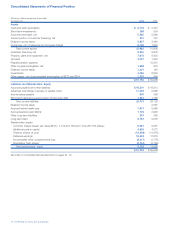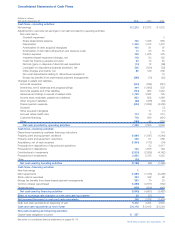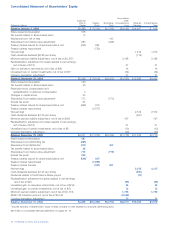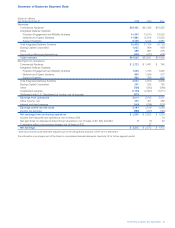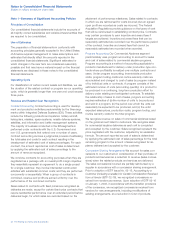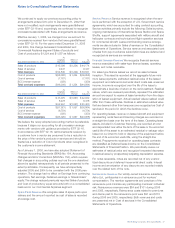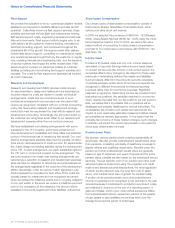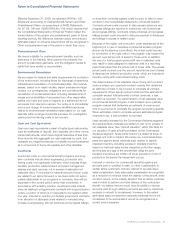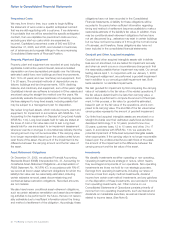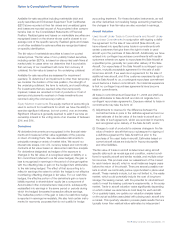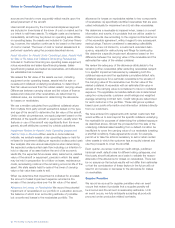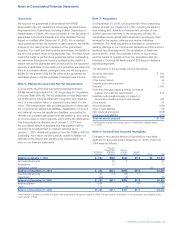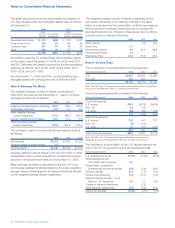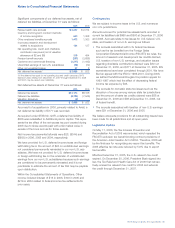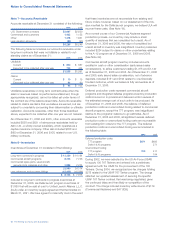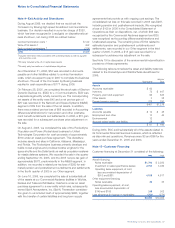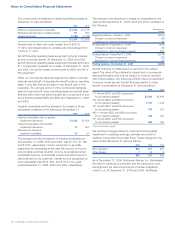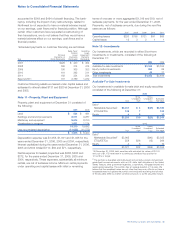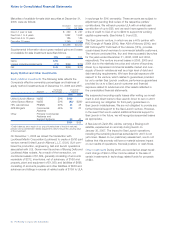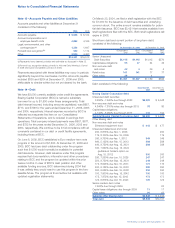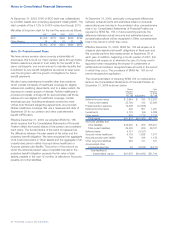Boeing 2006 Annual Report Download - page 54
Download and view the complete annual report
Please find page 54 of the 2006 Boeing annual report below. You can navigate through the pages in the report by either clicking on the pages listed below, or by using the keyword search tool below to find specific information within the annual report.52 The Boeing Company and Subsidiaries
Notes to Consolidated Financial Statements
sources and tends to more accurately reflect results upon the
actual placement of the aircraft.
Used aircraft acquired by the Commercial Airplanes segment
are included in Inventories at the lower of cost or market as it is
our intent to sell these assets. To mitigate costs and enhance
marketability, aircraft may be placed on operating lease. While
on operating lease, the assets are included in Customer financ-
ing, however, the valuation continues to be based on the lower
of cost or market. The lower of cost or market assessment is
performed quarterly using the process described above.
Asset Valuation for Assets Under Operating Lease, Assets Held
for Sale or Re-lease and Collateral Underlying Receivables
Included in Customer financing are operating lease equipment,
notes receivables and sales-type/financing leases. Sales-
type/financing leases are treated as receivables, and allowances
are established as necessary.
We assess the fair value of the assets we own, including
equipment under operating leases, assets held for sale or
re-lease and collateral underlying receivables, to determine if
their fair values are less than the related assets’ carrying values.
Differences between carrying values and fair values of finance
leases and notes and other receivables, as determined by
collateral value, are considered in determining the allowance
for losses on receivables.
We use a median calculated from published collateral values
from multiple third-party aircraft evaluations based on the type
and age of the aircraft to determine the fair value of the aircraft.
Under certain circumstances, we apply judgment based on the
attributes of the specific aircraft or equipment, usually when the
features or use of the aircraft vary significantly from the more
generic aircraft attributes covered by outside publications.
Impairment Review for Assets Under Operating Leases and
Held for Sale or Re-lease When events or circumstances
indicate, we evaluate assets under operating lease or held for
re-lease for impairment utilizing an expected undiscounted cash
flow analysis. We use various assumptions when determining
the expected undiscounted cash flow including our intention to
hold or dispose of an asset before the end of its economic
useful life, the expected future lease rates, lease terms, residual
value of the aircraft or equipment, periods in which the asset
may be held in preparation for a follow-on lease, maintenance
costs, remarketing costs and the remaining economic life of the
asset. We state assets held for sale at the lower of carrying
value or fair value less costs to sell.
When we determine that impairment is indicated for an asset,
the amount of asset impairment expense recorded is the
excess of the carrying value over the fair value of the asset.
Allowance for Losses on Receivables We record the potential
impairment of receivables in our portfolio in a valuation account,
the balance of which is an accounting estimate of probable
but unconfirmed losses in the receivables portfolio. The
allowance for losses on receivables relates to two components
of receivables: (a) specifically identified receivables that are eval-
uated individually for impairment and (b) all other receivables.
We determine a receivable is impaired when, based on current
information and events, it is probable that we will be unable to
collect amounts due according to the original contractual terms
of the receivable agreement, without regard to any subsequent
restructurings. Factors considered in assessing collectibility
include, but are not limited to, a customer’s extended delin-
quency, requests for restructuring and filings for bankruptcy.
We determine a specific impairment allowance based on the
difference between the carrying value of the receivable and the
estimated fair value of the related collateral.
We review the adequacy of the allowance attributable to the
remaining other receivables (after excluding receivables subject
to a specific impairment allowance) by assessing both the
collateral exposure and the applicable cumulative default rate.
Collateral exposure for a particular receivable is the excess of
the carrying value of the receivable over the fair value of the
related collateral. A receivable with an estimated fair value in
excess of the carrying value is considered to have no collateral
exposure. The applicable cumulative default rate is determined
using two components: customer credit ratings and weighted
average remaining contract term. Credit ratings are determined
for each customer in the portfolio. Those ratings are updated
based upon public information and information obtained directly
from our customers.
We have entered into agreements with certain customers that
would entitle us to look beyond the specific collateral underlying
the receivable for purposes of determining the collateral exposure
as described above. Should the proceeds from the sale of the
underlying collateral asset resulting from a default condition be
insufficient to cover the carrying value of our receivable (creating
a shortfall condition), these agreements would, for example,
permit us to take the actions necessary to sell or retain certain
other assets in which the customer has an equity interest and
use the proceeds to cover the shortfall.
Each quarter, we review customer credit ratings, published
historical credit default rates for different rating categories, and
third-party aircraft valuations as a basis to validate the reason-
ableness of the allowance for losses on receivables. There can
be no assurance that actual results will not differ from estimates
or that the consideration of these factors in the future will not
result in an increase or decrease to the allowance for losses
on receivables.
Supplier Penalties
We record an accrual for supplier penalties when an event
occurs that makes it probable that a supplier penalty will
be incurred and the amount is reasonably estimable. Until
an event occurs, we fully anticipate accepting all products
procured under production related contracts.


